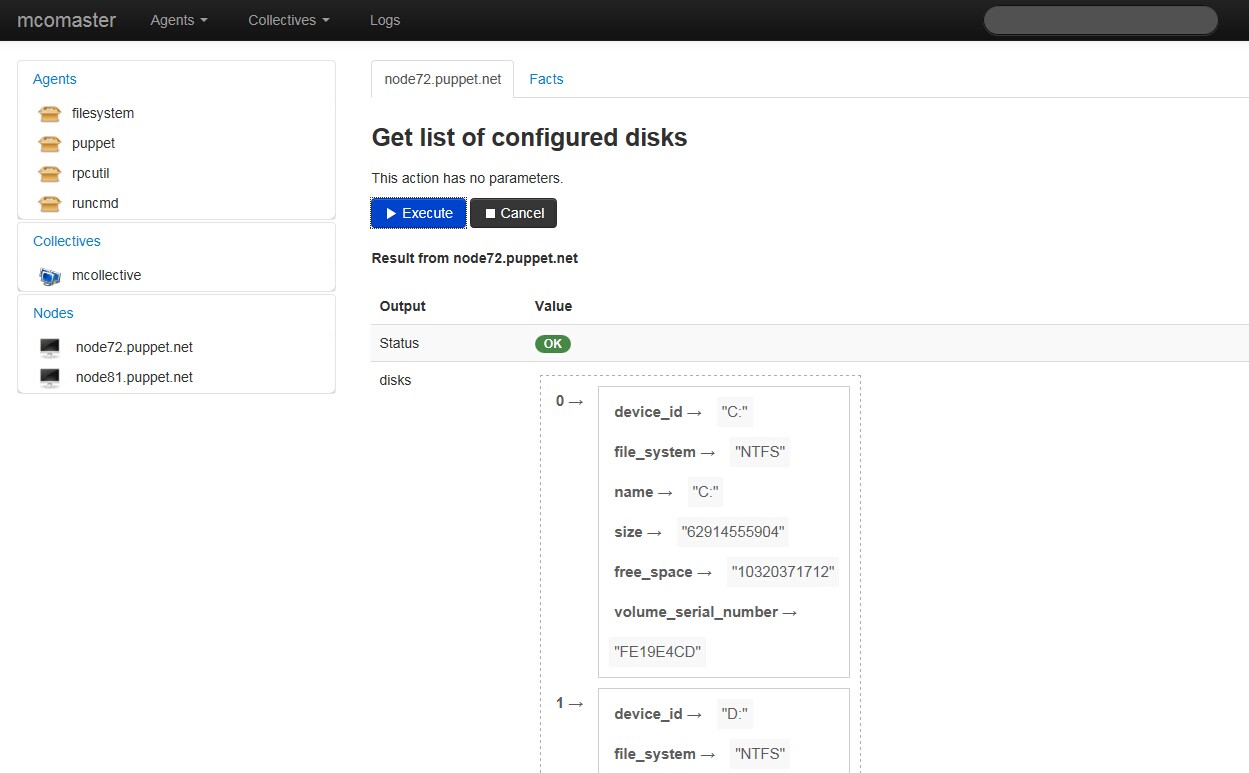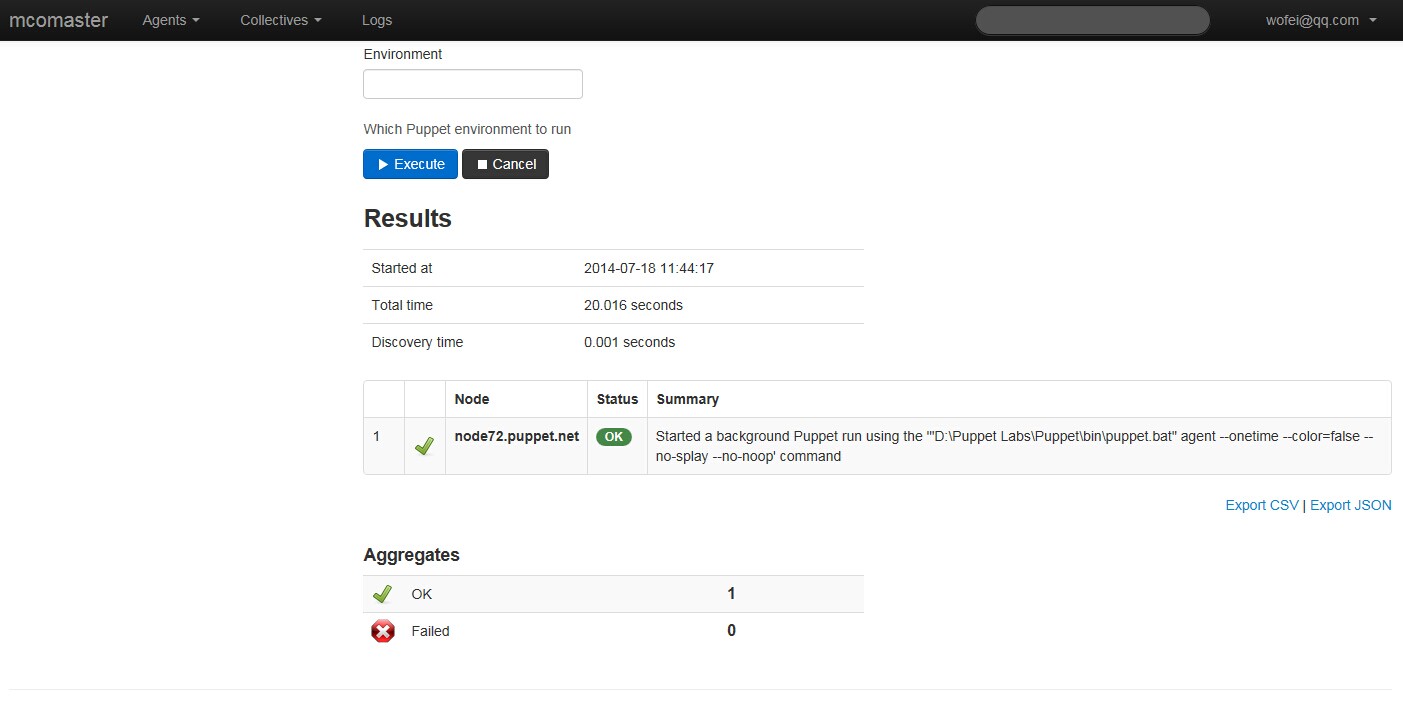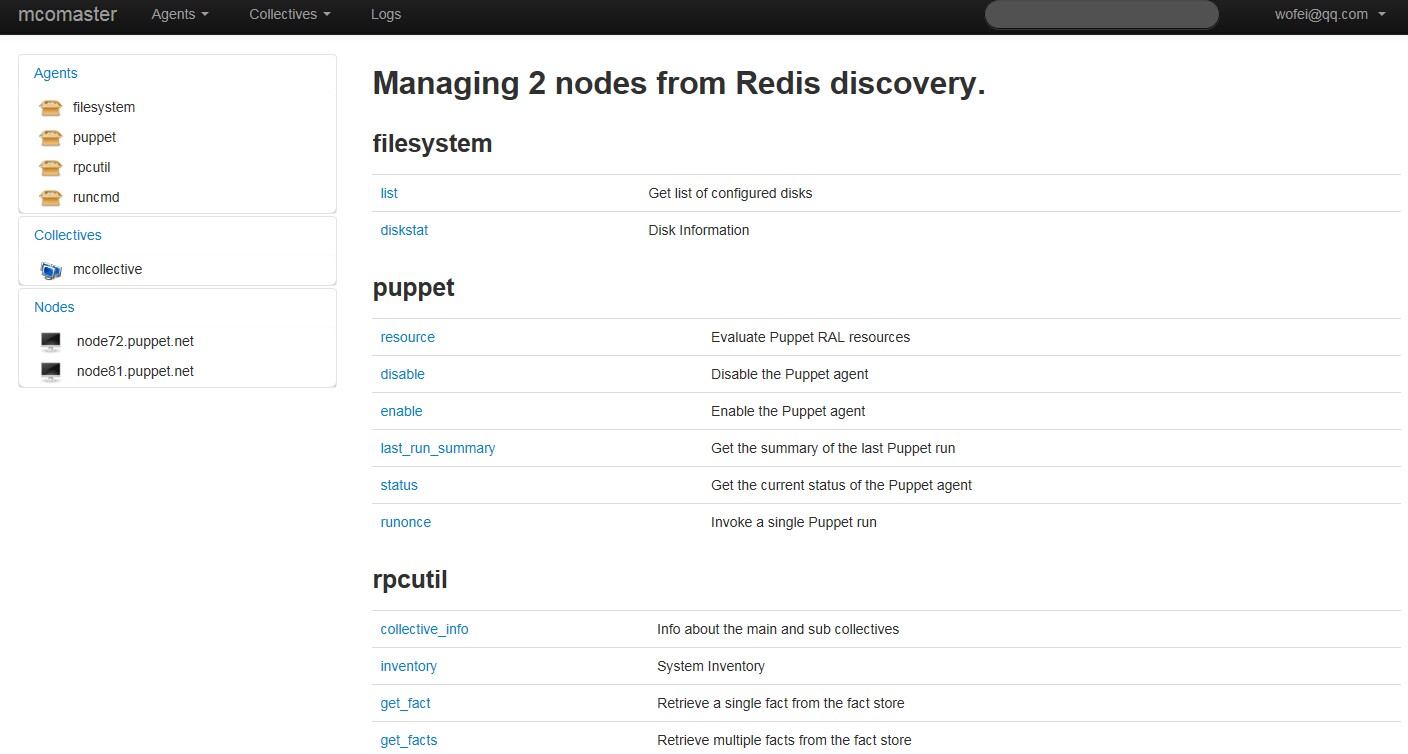mcollective的web控制台---mcomaster搭建
作者:互联网
使用mcollective有段时间,每次在控制机上写命令运行agent感觉挺不方便的,于是想有没有专门的mcollective的web console,搜了下发现有两个:kermIT和mcomaster.
kermIT看上去比mcomaster功能多些,不过因为kermIT是django开发,而mcomaster是ruby开发,这样就和mcollective、pupppet一脉相承,学习成本也低点。
本文就介绍一下mcomaster系统的搭建(OS:Centos6.2),其中涉及到的链接可能有些需要FQ。点击这里查看mcomaster官网的安装说明
===================================================================================================
1、mcomaster介绍
mcomaster是一个mcollective框架的web控制台系统,通过mcomaster可以执行节点机agent,也就是在mco的各种命令,而这些只需要动动鼠标,不用再远程到mco的控制机上敲命令。并且可以实时查看返回结果。所以这一切都需要我们先搭建好mcollective环境。如果你对mcollective还不了解,建议先去翻看一下我之前的文章:http://www.cnblogs.com/waiwofei/p/3698675.html
先来两张图,第一张是通过filesystem插件查看node72上的磁盘状况

第二张是对所有节点执行puppet同步,因为只有两个节点node72和node81,而node81上mcollective上没有装puppet插件,所以实际上只执行node72上的puppet

2、ruby环境的搭建
由于mcomaster要求必须是ruby1.9以上,而之前用yum安装的环境是是ruby1.87,最新的yum源都只是1.87,所以准备用源码安装ruby环境。下载 ruby2.12 源码。
# tar xzvf ruby-2.1.2.tar.gz # cd ruby-2.1.2 # ./configure --prefix=/usr/ruby/ # make && make install # cp /usr/ruby/bin/ruby /usr/bin/ # cp /usr/ruby/bin/gem /usr/bin/
然后查看ruby及gem的版本看看是否安装成功
# ruby -v ruby 2.1.2p95 (2014-05-08 revision 45877) [x86_64-linux] # gem -v 2.2.2
3、puppet安装
puppet在mcomaster的部署中并不是必须的,不过puppet是我们肯定会用到,所以先把puppet弄好,当然你也可以不进行这一步。这里采用gem安装puppet
# gem install puppet # cd /usr/ruby/lib/ruby/gems/2.1.0/gems/puppet-3.6.2 # cp conf/* /etc/puppet/ # cp ext/redhat/server.init /etc/init.d/puppetmaster # chmod +x /etc/init.d/puppetmaster # cp bin/puppet /usr/bin/ # mkdir /etc/puppet/manifests /etc/puppet/modules # service puppetmaster start 启动 puppetmaster: [确定]
接下来就是puppet服务器和客户端的常规配置,具体参考 http://www.chenshake.com/puppet-study-notes/
4、ActiveMQ安装
# yum install tanukiwrapper activemq activemq-info-provider
安装完成后来对ActiveMQ进行配置,如下
# vim /etc/activemq/activemq.xml
…
<simpleAuthenticationPlugin>
<users>
<!-- <authenticationUser username="${activemq.username}" password="${activemq.password}" groups="admins,everyone"/> --> #禁用
<authenticationUser username="mcollective" password="secret" groups="mcollective,admins,everyone"/> #配置通信的账号及密码
</users>
</simpleAuthenticationPlugin>
…
<authorizationPlugin> #配置权限,默认即可
<map>
<authorizationMap>
<authorizationEntries>
<authorizationEntry queue=">" write="admins" read="admins" admin="admins" />
<authorizationEntry topic=">" write="admins" read="admins" admin="admins" />
<authorizationEntry topic="mcollective.>" write="mcollective" read="mcollective" admin="mcollective" />
<authorizationEntry topic="mcollective.>" write="mcollective" read="mcollective" admin="mcollective" />
<authorizationEntry topic="ActiveMQ.Advisory.>" read="everyone" write="everyone" admin="everyone"/>
</authorizationEntries>
</authorizationMap>
</map>
</authorizationPlugin>
…
<transportConnectors>
<transportConnector name="openwire" uri="tcp://0.0.0.0:61616"/>
<transportConnector name="stomp+nio" uri="stomp://0.0.0.0:61613"/> #配置通信协议为stomp,监听61613端口
</transportConnectors>
# service activemq start Starting ActiveMQ Broker... # chkconfig activemq on # netstat -nlatp | grep 61613 #查看监听端口 tcp 0 0 :::61613 :::* LISTEN 33805/java
5、mcollective安装
首先安装mcollective-common,因为yum安装会同时ruby1.87等依赖,所以我们通过 https://yum.puppetlabs.com/el/6.2 下载对应的mcollective-common的rpm文件。
接着通过下面语句安装
# rpm -ivh mcollective-common-2.5.2-1.el6.noarch.rpm --nodeps
接着通过gem安装mcollective-client
# gem install mcollective-client # cp /usr/ruby/lib/ruby/gems/2.1.0/gems/mcollective-client-2.5.2/bin/mco /usr/bin/
接下来就是mcollective的控制机和节点机的一些常规配置,这里省略,如果你不清楚的话,可以参考这个链接:http://www.cnblogs.com/waiwofei/p/3698675.html
完成之后就是测试mco是否能正常使用,mco ping可以检查到2个节点机在线
# mco ping node72.puppet.net time=115.32 ms node81.puppet.net time=131.42 ms ---- ping statistics ---- 2 replies max: 131.42 min: 115.32 avg: 123.37
# mco inventory node72.puppet.net
Inventory for node72.puppet.net:
Server Statistics:
Version: 2.3.2
Start Time: 2014-07-17 10:22:05 +0800
Config File: D:\mcollective\etc\server.cfg
Collectives: mcollective
Main Collective: mcollective
Process ID: 11040
Total Messages: 131
Messages Passed Filters: 131
Messages Filtered: 0
Expired Messages: 0
Replies Sent: 8
Total Processor Time: 3.338 seconds
System Time: 0.561 seconds
Agents:
discovery filesystem puppet
registration rpcutil runcmd
Data Plugins:
agent fstat puppet
resource
Configuration Management Classes:
No classes applied
Facts:
mcollective => 1
6、mcomaster安装和配置
首先安装redis,mcomaster会使用到,具体查看这里:http://www.cnblogs.com/zhuhongbao/archive/2013/06/04/3117997.html
然后下载mcomaster源码,https://github.com/ajf8/mcomaster,解压到/usr/目录
# cd /usr/mcomaster-master/ # gem install bundler # bundle install
上面安装必要的gem包,会需要一些时间,完成后继续
# cp config/application.example.yml config/application.yml # cp config/database.example.yml config/database.yml 下面是初始化数据库,默认是sqlite # RAILS_ENV=production rake db:reset 然后给mcomaster添加使用账号 # RAILS_ENV=production script/add_user.sh -u username -p password -m 'email@domain.com' # rake assets:precompile
接下来我们需要对mcollective做一些配置
在mcollective控制机上执行
# cp mcollective/agent/registration.rb /usr/libexec/mcollective/mcollective/agent/ # cp mcollective/discovery/redisdiscovery.* /usr/libexec/mcollective/mcollective/discovery/ # vim /etc/mcollective/client.cfg 添加: default_discovery_method = redisdiscovery direct_addressing = yes plugin.redis.host = localhost plugin.redis.port = 6379 plugin.redis.db = 0
在mcollective节点机上执行
# cp mcollective/registration/meta.rb /usr/libexec/mcollective/mcollective/registration/meta.rb 编辑 server.cfg 添加 plugin.redis.host = (mco控制机ip) plugin.redis.port = 6379 plugin.redis.db = 0 registerinterval = 300 registration = Meta direct_addressing = yes
现在mcomaster应该可以运行起来了
# rails server -e production => Booting Thin => Rails 4.0.0 application starting in production on http://0.0.0.0:3000 => Run `rails server -h` for more startup options => Ctrl-C to shutdown server >> Thin web server (v1.5.1 codename Straight Razor) >> Maximum connections set to 1024 >> Listening on 0.0.0.0:3000, CTRL+C to stop
打开浏览器输入 http://192.168.11.170:3000


转载于:https://www.cnblogs.com/waiwofei/p/3851422.html
标签:web,mcomaster,puppet,usr,mcollective,cp,ruby 来源: https://blog.csdn.net/weixin_34209851/article/details/94314301